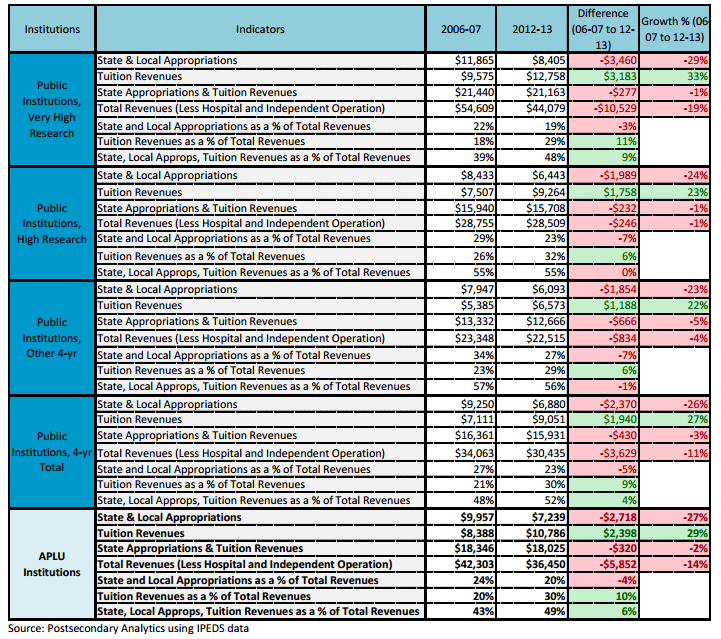You have /5 articles left.
Sign up for a free account or log in.
Four-year public colleges and universities have increased their education-related spending even as overall funding has declined.
The revenue declines are due to lowering state contributions. And while public universities have raised tuition rates to make up for large state funding losses, they have not fully offset the difference with tuition hikes.
Those are the findings from a new analysis the Association of Public & Land-grant Universities (APLU) has released. The report looked at revenue and spending on a per-student basis at 621 public four-year institutions between 2007 and 2013, including at 193 APLU member universities. The association's members include public research universities, land-grand institutions and state university systems.
Public universities are showing restraint with their spending, said Christine Keller, APLU's vice president for research and policy analysis.
“Institutions are trying not to pass along all of the lost revenue from the state appropriations cuts,” she said. “They understand that increasing costs are putting a burden on students and families.”
The 621 public institutions in fiscal 2013 spent more per student on educational expenses than they received in state funding and tuition dollars combined, according to the report, which was prepared by Postsecondary Analytics, a higher education research firm. Six years earlier, in fiscal 2007, the balance was different: publics received more appropriation and tuition funding than they spent on students.
This shift runs counter to the popular narrative that public institutions are "raising tuition over and over and over again without regard to the impact on students and that they're not thinking about how they can become more efficient," Keller said.
Per-student revenue from state appropriations and tuition and fees was $15,931 in 2013, down from $16,361 in 2007. Yet during the same period per-student education-related spending increased to $16,304, up from $15,776.
After adjusting for inflation, four-year public universities experienced state funding cuts of $2,370 per student during those six years, while tuition and fee revenues increased by $1,940 per student -- resulting in a net loss of $430 per full-time student.
The decrease in state funding has occurred during a time of growing enrollment for the 621 institutions -- which in 2013 was 6.3 million, up 9 percent from 2007.
Yet despite this uptick, and coupled with the decline in per-student state funding, public institutions increased educational and related expenditures by $528 per student.
And while universities didn’t shift the entire burden of state divestment onto students, students did bear the brunt of it. Universities on average reported a 27 percent hike in tuition revenues over six years and a 26 percent decrease in revenues from appropriations.
Among the institutions surveyed, average state and local appropriations per full-time student dropped from $9,250 to $6,880. Meanwhile, tuition revenues per student rose from $7,111 to $9,051.
Students at public universities with very high research activity (63 of 621 institutions surveyed) saw the largest increase in per-student educational spending, at 7 percent, compared to a 1 percent increase for all other institutions. The overall increase for the sector was 3 percent.
Yet per-student tuition revenues increased by 33 percent at those very-high-research universities, significantly steeper than the tuition hikes of their peers, which reported average per-student increases of 23 percent (high-research institutions) and 22 percent (other colleges and universities).
Public institutions are now more reliant on tuition dollars than on state funding, a trend that’s been noted by several recent studies. Advocates of public higher education, including APLU, have been encouraging states to increase their public funding, with increasing urgency.
In 2007, state and local funding accounted for 27 percent of revenue at the surveyed institutions. In 2013 it accounted for 23 percent. And tuition dollars that year made up 30 percent of colleges’ revenue, up from 21 percent in 2007.
Peter McPherson, APLU's president, said it’s “unsustainable” for students to bear the brunt of state divestment.
“Despite steep state budget cuts, universities have devoted more educational resources per student and are choosing to make cuts elsewhere,” he said in a statement. “States need to restore funding for public universities instead of viewing students and their families as alternative funding streams that can make their budgets look whole.”





